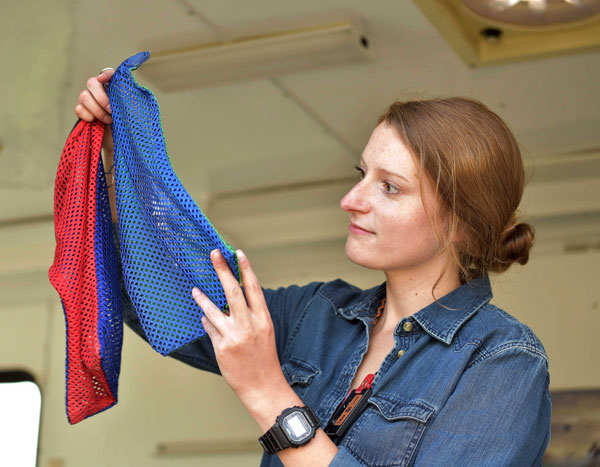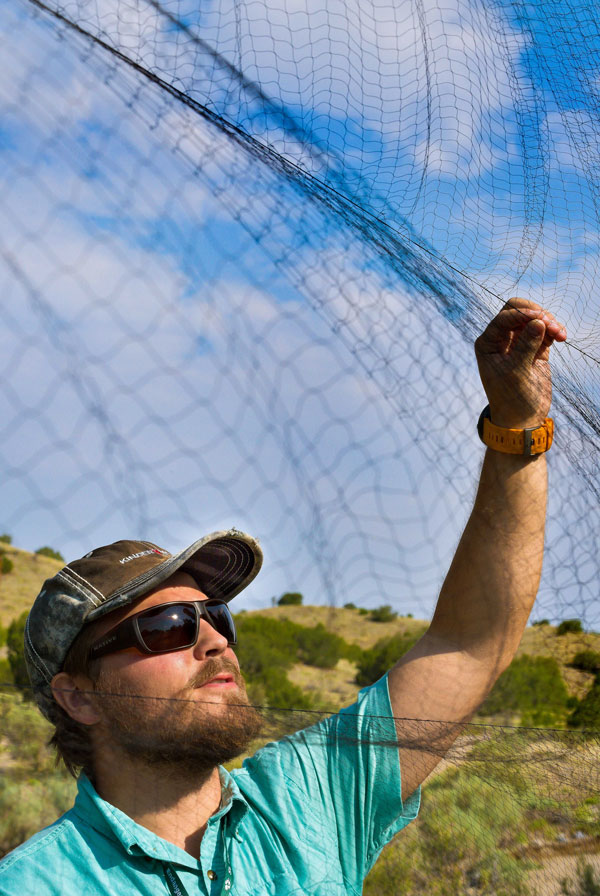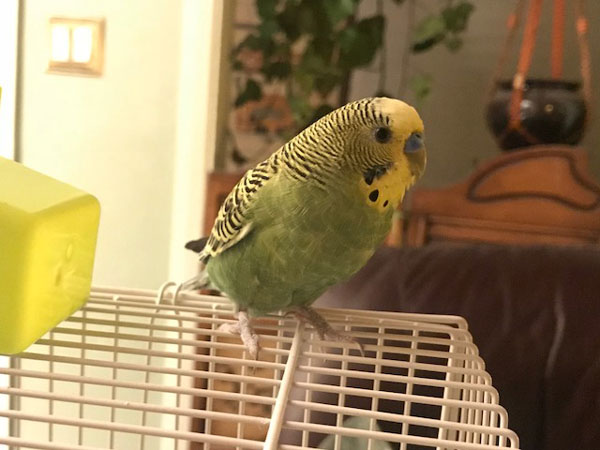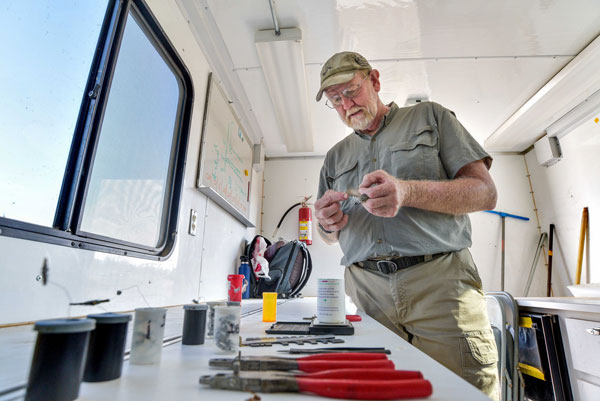Sandia’s feathered friends offer lessons to wildlife biologists
Its heart beating rapidly, a wild gray flycatcher sits in the palm of a steady hand, making side-eye contact and shaking, waiting for just the right moment to escape from its perceived human predator.
The moment lasts mere seconds, but it’s filled with emotion, from fear to connection to protection. Gathering courage, the bird flies back into Sandia open space, its home for a few more weeks until the weather starts to change.
Moments like this don’t happen for most people, but for a

handful of Sandia biologists in the ecology program, they do. On a regular basis, biologists spend their days working with birds, looking for reptiles and monitoring other wildlife around the Labs.
The days they get to be in the field are their favorites, and some — particularly the shifts spent with birds — begin well before sunrise in a parking lot where the team gathers their gear and jumps in dusty trucks, flipping on headlights and driving 20 minutes southeast in the dark.
One morning in early August, the sky seemed especially thick and starless, a half moon shining from the very top of the night. Maybe clouds were left from the evening before, or perhaps it was the haze from distant wildfires. The roads were muddy and bumpy, and when the team arrived at their destination, it smelled like rain.
Team lead Steve Cox reminded the team of four to stay safe and watch for snakes, then they grabbed bags of nets and went their separate ways in the dark to set up the nets before sunrise, hoping to catch birds for monitoring purposes.
Where do the birds go?
The group works on an international collaborative program called Monitoring Avian Productivity and Survivorship, established in 1989. The first week of August was Sandia’s last week participating in MAPS for the year. The following week they would start tracking migrating birds in the area. More than 1,200 MAPS monitoring stations are located across the country and Canada, with participating biologists providing data that give insight on avian population, breeding and the effects of weather, climate and habitat loss.
When Sandia biologists capture birds, they collect information on age, sex and body condition, and place a tiny metal band around one leg. Each band is stamped with a unique number. Biologists who catch a banded bird later can use the number to find out where and when the bird was first banded. The data collected ultimately adds to MAPS research on avian survival, reproductive rates and movement patterns.

“There are very specific protocols for every organization that participates in this program, and it’s really great to be part of this,” Steve said. Procedures describe how long to leave the nets up (six hours) and how often they should be checked. Every 30 minutes is standard.
Sandia biologists gather information not only to support national studies, but also to determine local trends. They try to track which birds come back every year, if any species are dwindling or increasing in number and where they may be migrating. It takes years to determine such changes.
Steve continued talking while setting up the nets, each about 40 feet long and 8 feet high.
“This is a mist net. It looks kind of like a big hair net, and it does a reasonable job of catching birds,” he said, adding that the nets can only capture a small percentage of the birds in the area due to their relatively
small sizes. “We’re not sampling anything above these nets. Some people will say you’re only catching a tenth of one percent. Yeah, but that’s measurable.”
While walking to the next net location, Steve paused to listen every once in a while.
“I was just listening to a songbird,” Steve said. “Not only do we catch birds, we also are noting all of the other birds we encounter here either by seeing or hearing.”
Bird backpacks track threatened species
The team had been listening for gray vireos they are trying to track because the species is threatened. Last year, they placed small geolocators resembling tiny backpacks on 13 gray vireos to see where the birds go for the winter.
Sandia wildlife biologist Matthew Baumann came up with the idea for a few reasons. The gray vireo is listed as a species of concern in the state, and the geolocators provide more information, including where they migrate and spend the winter months. No one had put geolocators on gray vireos, and Kirtland Air Force Base happens to have one of the highest populations of the species in New Mexico.
Free bird: When this non-native parakeet was spotted in Tech Area 4 earlier this year, Sandia wildlife biologists rescued him and found him a new home. Technologist Anastasia Gaiser adopted the bird after trying to find its owner. His name is Meiko.(Photo by Anastasia Gaiser)

Recording the time and angle of the sun, geolocators track roughly where the birds have been, and this year Sandia biologists were able to recapture four of the 13.
“It’s pretty remarkable given that previous research on other species has shown that sometimes you only get one back,” Matthew said, adding that they could capture more next year. “People have researched gray vireos and found that they nest in nearly the same tree as the year before. They come back at least within a couple hundred meters. They know the habitat they like, and where the best territories are.”
Matthew said preliminary analysis suggests the Kirtland gray vireos spend their winters in Baja and southern Sonora, Mexico.
Ecology team educates workforce
Most people working at the Labs are surprised to find out Sandia has wildlife biologists on staff, Steve said.
The ecology program conserves plant and animal life on Sandia property and assists with ecological issues and concerns that arise during work at the Labs. They also collect data on plant and animal species to further understanding of resources on site, and educate members of the workforce on conservation. Team members collect biological inventory data to support site activities and maintain regulatory compliance while preserving resources. Plant and animal data collected by the ecology program also advances the understanding of on-site ecological processes.
The ecology program is responsible for all biological and ecosystem resource management on DOE-permitted lands, including work areas, operational areas and remote areas.
“Ecology is a really important science, so it’s great that Sandia supports what we do,” said wildlife biologist Callan Pope.
The workforce is required to follow laws on wildlife and vegetation. The Migratory Bird Treaty Act makes it illegal to capture, handle, put at risk, kill or maim birds that are indigenous to North America. This can be difficult to explain to employees when birds or nests are discovered where technical or experimental work takes place. At times, biologists meet resistance from researchers under deadlines and those who don’t understand why birds can’t be moved.

WING SPAN — Wildlife biologist Steve Cox examines the wings of a bird captured at Sandia. During this bird banding session, the ecology team caught ten different species of birds.
“A lot of the challenge is trying to educate people on what we’re doing and why we’re doing it,” Steve said. “Behavior modification is a big part of our job.”
Steve tries to find something each individual can connect with when he educates them. For some, it’s following laws; for others, it may be safety. Sometimes they can connect with the wildlife itself.
“There can be a lot of emotion associated, and you don’t necessarily want to let emotion override in the situation,” he said. “What I find is, if you can figure out what’s important to them and try to work at that level, that sometimes helps. We don’t have the luxury of sitting down and having therapy sessions with people on why it’s important to have wildlife.”
Other challenges of the job include being in the field when it’s hot, cold, windy or bugs are out. In spite of the challenges, he said it’s worth it to be outside regularly when most other Sandia employees are in offices or labs.
The best part of the job? “It’s always the field work, no question, that’s hands down,” Steve said.
‘No middle ground’ for avian passion
Between net checks, Callan asked the team what they heard while they were out.
“Mourning doves, black-throated sparrows, Woodhouse’s scrub jays, canyon towhee, probably a few others,” said wildlife biologist Evan Fahy. The team chatted for a while about birds and other breeds they hoped to see. Callan wanted to see sparrows and at least one Cassin.
“I’m hoping we get a black-headed grosbeak,” said Sandia intern Austin Lewandowski. “And a golden eagle,” he said, laughing, as the nets generally catch small birds, not eagles.
See-through skin: Scientists can blow across the bodies of some birds to part their feathers and see how much fat and muscle they have. Blowing across the feathers provides a clear view of accumulated fat through the bird’s translucent skin. More fat tends to mean they are migrating or preparing to migrate.
The first catch of the day was the gray flycatcher, and Steve explained while some species look similar, each has some slight, unique differences. He explained how biologists look at the bird’s bill, the web of the outer tail feather, its coloring and the wing span.
“One fascinating thing about these birds is their skin is transparent,” Steve said. “We can blow across its belly, spreading the body feathers, and see muscles and bones. We subjectively measure the fat, which is important. During migration, the bird’s whole body changes. Their flight muscles get bigger, and they put on fat. When not in migration, they have very little fat, and have to eat constantly for energy.”
Once they have all the measurements they need, and a band is secured on one leg, the bird is set free again. If the team still has some time, they might talk about birds and laws, and bring up questions about avian survival: What are airports doing (or not doing) for birds? How does construction affect wildlife? And how can non-biologists help?
Their passion runs deep. It’s more than a day job for some. Steve has a favorite bird tattooed on one arm. He spends weekends at the Rio Grande Nature Center watching birds, and searches for them in the mountains. He has lists of birds he’s seen, everywhere from his backyard to six out of the seven continents.
“I used to think I was really a normal person, but when you get right down to it, I’m probably not,” Steve said. “I do enjoy birdwatching. I’ve been collecting information on birds for 30 years. I don’t want to tell people I have fun doing this stuff because I’m afraid they’ll make me do something different.”
Callan said she realized in college, “the people you meet who are passionate about birds are just very extreme. There’s no middle ground. And getting birds in the hand, there’s nothing like that.”